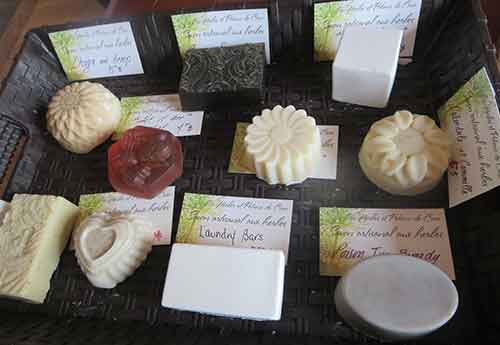Herbalism is often considered to be an alternative form of medicine, but there’s nothing alternative about it. Plants have been used to treat a variety of illnesses for thousands of years. Long before Aspirin and Advil, our ancestors achieved pain relief with willow or meadowsweet tea. What many of us view as humble weeds actually can provide powerful and effective medicine. Just ask massage therapist and herbalist, Caroline Rivard.
Caroline opens the door to her home north of Montreal, Canada, and greets me with a beautiful smile. It’s the first time we’ve met, but I already feel like I’ve known her forever. Her passion for medicinal plants is infectious; before long I’m walking through her impressive backyard garden, learning about the magic behind each of the plants growing there.
“Plants are amazing,” Caroline says. “They have so much to give.”
How Her Gardens Grow
Once a self-described workaholic, Caroline only discovered the world of herbalism when she left her bustling massage therapy practice in the city and moved north. With deer and wild turkeys more numerous than clients, she took up running and had a moment of clarity one day when she saw a group of weeds and wildflowers growing together in the ditch. Knowing that some of them held medicinal properties, she decided to learn about the plants and work with them to help people.
“I do a lot of research, and then I go shopping in the bush,” she laughs.
Today, her sprawling gardens are nothing short of awe-inspiring. Ranging from beautiful blooms like nasturtiums, calendula, centaurea, and bee balm, to the more subdued such as plantain, fennel, rosemary and holy basil, Caroline has more than 35 different medicinal plants growing on two separate properties. With them, she makes healing ‘potions’ in the form of salves, drops, infused oils, teas, and even soaps.
So Many Benefits
She greets all plant life with an open mind and an open heart. Even stinging nettle, a weed many gardeners despise. But Caroline describes nettle as her friend and a serious nutrient-booster. In a world where we’re not getting enough goodness from our foods, drinking nettle tea once a day for six weeks can deliver some major perks. Caroline says she noticed a difference in the appearance of her hair, nails, and skin.
The benefits of each plant are plentiful; used in different ways, they can treat multiple health problems:

Holy Basil
This is an incredible stress and anxiety reliever. It’s also high in anti-inflammatory and antioxidant properties, while also being good for digestion and aching joints. Caroline made me some Holy Basil Tea, and it was both tasty and totally relaxing. It may have even added a few years to my life!
Centaurea Cyanus (Cornflower)
This flower has more to offer than just beautiful, bright blue blooms. It’s known for its anti-inflammatory properties and is commonly used as a soothing eyewash to reduce puffiness, dark circles, and even treat infections such as conjunctivitis.
Calendula
These tiny yellow and orange flowers are Caroline’s ‘go-to’ ingredient for many of her potions, and not just because they’re pretty. Calendula has the ability to heal skin tissue and is also antifungal and antibacterial. If you drink it in a strong tea, it can help with peptic ulcers and inflammation from bowel disease.
Jewelweed (Impatiens Capensis)
This is a no-brainer for herbalists looking to treat the burning and blistering rash caused by poison ivy. Its antifungal properties also work wonders on athlete’s foot.
Bee Balm (Monarda Didyma)
I tasted some of this straight from Caroline’s garden, and it’s dang delicious. The bright red blooms are spicy and can be used as an antiseptic, carminative, diaphoretic, diuretic and a stimulant. It is often used in medicinal infusions to treat colds, migraines, sore throats and fevers, as well as gastric problems like nausea.

We’re only scratching the surface of what medicinal gardens have to offer. Caroline uses rosemary for hair care and massage therapy creams, arnica to make bruises fade faster, and plantain to treat painful insect stings and bites.
Her homemade face cream contains honey, roses, and peonies; it smells and feels like a day at the spa, only better. Her “Bobo Cream” is made with nine plants total and treats everything ranging from rashes, cold sores, and psoriasis, to eczema, scars and minor burns.
To the naysayers, Caroline says she truly believes that our bodies prefer to heal naturally rather than be bombarded with doses of antibiotics. There is medicine all around us.
It Ain’t Easy
Of course, there are challenges to growing a medicinal garden. Research is of the utmost importance; knowing what qualities various plants have and how to combine them for the desired result takes so much time and effort. It’s both a science and a balancing act.
Herbalists must also work with the seasons. When the weather cooperates, gardens show their appreciation. When growing conditions turn sour, it will be another year in some climates before you can try again. Patience is a virtue, and Caroline says learning to “go with the flow” is absolutely necessary for her line of work.
“Allow yourself to fail,” Caroline says. “Don’t be so hard on yourself for things that don’t work out.”
Herbalist or not, that’s pretty sound advice.
Caroline firmly believes that the more love and thought you give to your gardens, the more they will do for you. She talks to her plants and listens to what they have to say. At the end of the day, she leaves feeling inspired and ready for the next potion.
All-natural and handcrafted with love.



Can you tell me where I can get some of these ?? I live in Montreal Canada ..Thank you
Hello Janet,
This garden is only an hour north of you in the Laurentians. If you’re interested in her products, you can email her at carolinerivard@hotmail.com. Having tried her products myself, I can say they are outstanding! Enjoy!